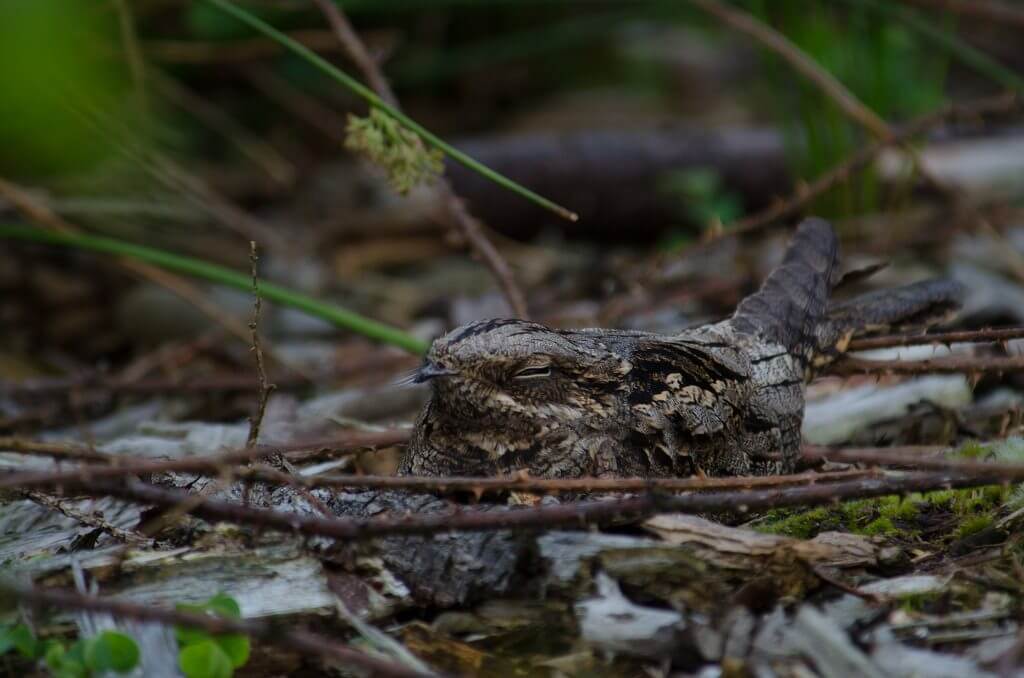Tim writes: Like Desert Island Discs, if I had to choose just eight species of bird to be stranded on a desert island with, Nightjar would definitely be on the list. It took me ages but I finally succeeded in finding a nest of my local Nightjars in the Peak District moors. This is quite an achievement as they are extraordinarily elusive. The camouflage is unbelievably effective and by sitting motionless they do not betray their presence. Another adaptation is visible here, the fan of rictal bristles around the bill which increases their insect-catching ability as they fly around open-mouthed. I suppose it’s a bit like a baseball glove increasing the area of catch.
The scientific name Caprimulgus translates as goat-milker from the ancient belief (dating back before Aristotle) that Nightjars fed from goat udders, which caused them to stop producing milk, and eventually to go blind. This seems to be based on the simple observation that they have large mouths that might be capable of clamping on a goat’s udder, but is really to catch insects with. Because milk is a mammalian product, birds have never evolved the enzyme lactase that enables them to digest milk. It was fat that the Blue Tits used to steal off the top of the milk, and they stopped doing this once our tastes changed to low-fat semi-skimmed milk.
Taken with Nikon D7000 and Nikkor 80-400mm at 400mm 1/400 f5.6 IDO 800
[registration_form]
And the other 7?
What a great reward for a huge amount of effort, Tim ! Beautiful bird, beautiful picture. When you say ‘Peak District Moors’ is this in fact on a felled forest area ? Those look very like spruce branches around the nest. And, in light of all the discussion on disturbance on this blog recently, you can see clearly that the nest is on bare, not vegetated ground – Nightjar simply won’t nest on growing vegetation, even rabbit mown grass, which is one reason there are now so many on forest clearfells which do provide that brief window of bare ground.
Hi Roderick. I’ve spent a lot of time surveying Nightjars in the Peak District, particularly over the last 6 years. We have two basic habitat types;
1) moorland fringe, usually slopes with a mixture of bracken and heather dominating the ground layers, with a scattering of trees and bushes, and, not infrequently, gritstone outcrops. In these habitats generally thick ground cover is not an obstacle to territory selection providing there are some (micro) barer areas.
2) clearings (here mainly in commercial/abandoned conifer plantations) which tend to be occupiable for 5-10 years until regeneration/replanting takes hold. New clearings are often occupied very rapidly, e.g. the following spring after a winter felling (sometimes by multiple pairs).
Obviously these two niches can be found in close proximity. Virtually all sites I am aware of are in the c.250-350m asl range (territories can include land down to c.200m) but this (presumably) reflects habitat availability on ‘marginal’ land rather than any other altitude related factors. In my experience only the very fringes of managed grouse moors are used where these abut the specified habitats. However ‘moorland’ in a broad sense is often not too far out as descriptive term, though locally it’s almost always qualified with ‘fringe’. Outside the Peak district we have another local breeding site, though, again, it contains habitat of the two outlined types and at similar altitude.
“Like”
That is a fabulous picture Tim.
Great pic Tim. Would I be right in saying that if we had more of a genuine habitat ‘mosaic’ in the uplands which would include areas of woodland and shrub then the nightjar is one among many species that would benefit? The current regime on grouse moors can’t be much good for them meaning they are effectively excluded from vast stretches of the countryside.
I completely agree Les (see reply to Roderick above, and Tim’s comment below); open grouse monoculture is not Nightjar habitat.
Yes and the same for black grouse I believe – grouse (red) moors have effectively excluded them from vast stretches of the countryside then the estates say they are helping black grouse by predator control. Laughable, they’ve helped drive their population down in the first place. One hell of a lot of British wildlife would benefit from change everything from juniper to nightjars, hundreds of thousands of hectares of enhanced wildlife habitat – what difference could that make to future ‘State of Nature’ reports? I’m in awe of your surveying work – I helped count newts once which is about it.
Thanks for all the comments. I haven’t decided on my final 8 desert island birds Laura but Merlin and Hawfinch would definitely be among them. Roderick you read all the clues correctly. The nest was in a replanted area of clearfell, but it was adjacent to an intensive grouse factory. I also agree with you Les that a habitat mosaic is better for Nightjars. The intensive burning on a grouse moor creates a monoculture of heather with none of the small trees that are so characteristic of Nightjar breeding sites. There are plenty of Nightjars in the scrubby moorland fringes but few, if any in the wall to wall heather.
Tim (if you are reading) I’d love to know the specific site. I appreciate potential site sensitivity so perhaps drop me an Email via Mark?